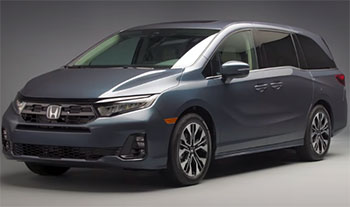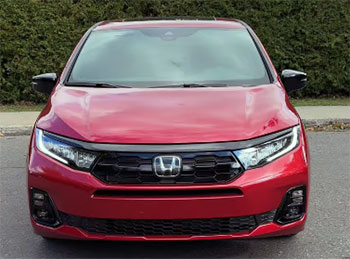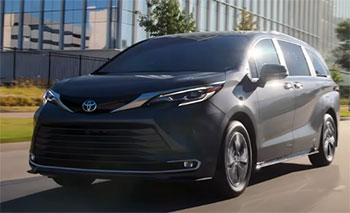As a parent juggling school runs, soccer practices, and weekend road trips, I’ve spent countless hours researching the perfect minivan. The 2025 Honda Odyssey and Toyota Sienna stand out as top contenders, each promising space, comfort, and reliability.
My goal is to share my firsthand insights, comparing these family haulers through a detailed lens to help you decide which fits your lifestyle. From innovative seating to fuel efficiency, I’ll break down their strengths and weaknesses, ensuring you have a clear picture to make an informed choice for your family’s next adventure.
Honda Odyssey Vs. Toyota Sienna Comparison
| Feature | Honda Odyssey (2025) | Toyota Sienna (2025) |
|---|---|---|
| Starting MSRP | $42,220 | $39,185 |
| Engine | 3.5L V6, 280 hp | 2.5L Hybrid 4-cylinder, 245 hp |
| Fuel Economy (city/hwy/comb) | 19/28/22 mpg | 36/36/36 mpg (FWD), 35/36/35 mpg (AWD) |
| Drivetrain | Front-wheel drive only | FWD standard, AWD available |
| Seating Capacity | Up to 8 | Up to 8 |
| Cargo Space (behind 3rd/2nd/1st row) | 32.8/88.6/144.9 cu ft | 33.5/75.2/101.0 cu ft |
| Second-Row Seating | Magic Slide seats (removable, slide forward/backward) | Non-removable, airline-style sliding seats with up to 25 inches of travel |
| Safety Features | Honda Sensing (adaptive cruise, lane-keeping, collision mitigation), CabinWatch | Toyota Safety Sense 2.0 (adaptive cruise, lane assist, pre-collision), Secondary Brake |
| Infotainment | 9-inch touchscreen, Apple CarPlay/Android Auto, CabinTalk, optional rear entertainment | 9-inch touchscreen, Apple CarPlay/Android Auto, optional rear entertainment |
| Reliability (J.D. Power) | 77/100 | 76/100 |
| Warranty | 3-yr/36,000-mile basic, 5-yr/60,000-mile powertrain | 3-yr/36,000-mile basic, 5-yr/60,000-mile powertrain, 10-yr hybrid battery |
| Unique Features | Integrated vacuum (Touring/Elite), Multi-Zone Audio | Optional in-car vacuum/fridge (Platinum), 4-zone climate control |
My Experience With the Honda Odyssey

Climbing into the 2025 Honda Odyssey felt like stepping into a mobile command center tailored for family life.
The exterior, with its sleek lines and new Solar Silver Metallic paint, turned heads in my neighborhood. Inside, the cabin was a revelation—spacious, thoughtfully designed, and brimming with practical touches.
The Magic Slide second-row seats were a standout feature; I could slide them forward for easy third-row access or remove them entirely to haul everything from soccer gear to a new bookshelf.
The 3.5L V6 engine, pumping out 280 horsepower, made highway merges feel effortless, and the 10-speed automatic transmission shifted with precision.
However, the 19 mpg city fuel economy hit my wallet harder than I’d hoped, especially with my daily errands.
The 9-inch touchscreen was user-friendly, supporting Apple CarPlay and Android Auto, but it occasionally lagged when switching between apps, which was frustrating during busy mornings. The CabinWatch system, a rear-facing camera displaying on the dashboard, let me keep an eye on my kids without twisting around—a lifesaver during tantrums or snack spills.
CabinTalk, the in-car PA system, meant I could give directions to the backseat crew without raising my voice. The optional 12.8-inch rear entertainment system kept my kids entertained with movies on long drives, though I wished it was standard on lower trims.
Driving the Odyssey was a pleasure; the suspension absorbed potholes, and the steering was light yet responsive. On a rainy weekend trip, though, the lack of all-wheel drive made me cautious on slick roads, as traction felt less secure than I’d hoped. Wind noise crept into the cabin at highway speeds, despite the active noise cancellation, which was a minor annoyance during long drives.
The integrated vacuum (available on Touring and Elite trims) was a godsend for cleaning up crumbs and dirt, a constant reality with young kids. Overall, the Odyssey felt like a reliable, family-focused machine, but its fuel thirst and lack of AWD left me wanting in certain scenarios.
Pros Of the Honda Odyssey

- Unmatched Cargo Versatility: The Odyssey’s 144.9 cubic feet of maximum cargo space is a class leader. I easily fit strollers, camping gear, and even a small mattress when helping a friend move. The Magic Slide seats made reconfiguration a breeze, adapting to any load.
- Robust V6 Performance: The 280-hp 3.5L V6 engine delivered confident acceleration. Whether merging onto highways or climbing hills with a full load, the Odyssey never felt underpowered, and the 10-speed transmission ensured smooth shifts.
- Parent-Centric Technology: CabinWatch and CabinTalk were game-changers. Monitoring my kids via the dashboard screen and communicating through the PA system made drives less stressful. The rear entertainment system, with its crisp display, kept my kids occupied for hours.
- Smooth and Comfortable Ride: The suspension handled bumps with ease, making daily commutes and long trips comfortable. The leather-trimmed seats (standard on base trims) felt upscale, and the tri-zone climate control kept everyone happy, even during summer heatwaves.
- Top-Tier Safety Features: The Honda Sensing suite, including adaptive cruise control, lane-keeping assist, and collision mitigation braking, felt reliable. The Odyssey’s five-star NHTSA frontal crash rating gave me confidence in its ability to protect my family.
- Slight Reliability Advantage: With a J.D. Power score of 77/100, the Odyssey edges out the Sienna slightly, reassuring me about its long-term dependability for years of family adventures.
- Built-In Vacuum Convenience: The integrated vacuum (Touring/Elite trims) was a lifesaver for quick cleanups. After a beach trip, I cleared sand and snacks in minutes, keeping the interior pristine.
- Spacious Third Row: Unlike some minivans, the Odyssey’s third row comfortably fit adults. During a family reunion, my tall cousins rode back there without complaints, a rare feat in this class.
The Odyssey’s interior was a haven of flexibility. I could switch from seating eight to hauling cargo in no time, and the V6’s power made every drive feel effortless. The family-focused tech, especially CabinWatch, felt like it was designed with parents like me in mind. The safety suite was robust, and the high crash-test scores were reassuring. The vacuum was a small but brilliant touch, saving me from constant trips to the car wash. While not perfect, the Odyssey’s blend of space, power, and thoughtful features made it a strong contender for my family’s needs.
Read More: My Thoughts On Acura MDX Vs. Lexus GX
Cons Of the Honda Odyssey
- No All-Wheel Drive Option: In my area, where snow and rain are common, the lack of AWD was a noticeable drawback. The front-wheel drive struggled on wet roads, making me wish for the Sienna’s AWD capability.
- Thirsty Fuel Economy: The 19/28/22 mpg (city/highway/combined) was a budget strain. With gas prices fluctuating, I found myself refilling the tank more often than I’d like, especially compared to hybrid alternatives.
- Higher Starting Price: At $42,220, the Odyssey costs more than the Sienna’s $39,185. For families watching their budget, this price gap could make the Sienna more appealing, especially with its hybrid savings.
- Infotainment Frustrations: The 9-inch touchscreen, while feature-packed, occasionally froze or lagged. Switching between navigation and music during a busy morning was more cumbersome than I expected.
- Cumbersome Seat Removal: The Magic Slide seats are versatile, but removing them was a hassle, requiring two people and some muscle. This was inconvenient when I needed to quickly clear space for large items.
- Noticeable Cabin Noise: Despite active noise cancellation, highway drives brought wind noise that disrupted conversations. It wasn’t loud, but I expected a quieter cabin for a minivan in this price range.
- Limited Features on Base Trims: Premium features like the vacuum and advanced rear entertainment are exclusive to higher trims, pushing the price toward $50,000. This made the base model feel less competitive.
- No Hybrid Option: In an era of rising fuel costs, the Odyssey’s lack of a hybrid powertrain felt like a missed opportunity. I envied the Sienna’s efficiency during my frequent suburban drives.
The Odyssey’s fuel economy was a constant reminder of its V6’s appetite, especially when I saw my gas bills pile up. The absence of AWD was a concern for winter drives, and the infotainment glitches tested my patience during hectic moments. Removing the seats was more effort than I’d hoped, and the cabin noise at high speeds was a minor letdown. While the Odyssey excels in many areas, these drawbacks made me question its value compared to more efficient or versatile competitors.
My Experience With the Toyota Sienna

The 2025 Toyota Sienna won me over with its eco-friendly hybrid powertrain and sleek, modern design.
The 36 mpg combined fuel economy was a revelation, slashing my gas expenses compared to traditional minivans.
The interior felt fresh and upscale, with a bridge-style center console offering clever storage solutions and a 9-inch touchscreen that responded quickly to my inputs.
The optional all-wheel drive (available on all but the base trim) gave me confidence during rainy commutes, a must for my area’s unpredictable weather.
However, the non-removable second-row seats were a major frustration when I needed to haul bulky items like a new coffee table, limiting the Sienna’s flexibility.
The hybrid’s 245 horsepower felt adequate for city driving but strained on steep inclines or when the van was fully loaded with passengers and gear. The four-zone climate control was a nice touch, ensuring everyone stayed comfortable, and the optional in-car fridge (Platinum trim) was a hit during summer road trips.
The Sienna’s ride was smooth, though the steering felt heavier at low speeds, making parking lots a bit of a workout. Unlike the Odyssey, it lacked parent-specific tech like CabinWatch, which I missed when trying to manage my kids in the back. The optional rear entertainment system was decent but felt less seamless than the Odyssey’s. Overall, the Sienna impressed with its efficiency and style but fell short in versatility and power.
Pros Of the Toyota Sienna
- Exceptional Fuel Efficiency: The hybrid’s 36/36/36 mpg (FWD) was a budget-saver. I spent far less on gas during my daily errands, making the Sienna a practical choice for cost-conscious families.
- All-Wheel Drive Availability: The AWD option (standard on higher trims) was a game-changer for wet and snowy conditions. It gave me peace of mind during winter drives, unlike the Odyssey’s FWD-only setup.
- Affordable Starting Price: At $39,185, the Sienna undercuts the Odyssey by over $3,000. This made it easier to justify adding features like the rear entertainment system without breaking the bank.
- Stylish and Modern Cabin: The bridge-style console and SofTex upholstery gave the interior a premium feel. The woodgrain accents added sophistication, making the Sienna feel like more than just a family hauler.
- Robust Safety Suite: Toyota Safety Sense 2.0, with pre-collision braking, lane departure alerts, and a Secondary Collision Brake, matched the Odyssey’s safety credentials. The five-star NHTSA rating was reassuring.
- Proven Hybrid Reliability: Toyota’s hybrid system, backed by a 10-year battery warranty, felt like a safe bet. Consumer Reports’ high reliability ranking gave me confidence in its long-term durability.
- Quiet and Serene Cabin: The hybrid’s quiet operation and effective insulation made the Sienna’s interior a calm oasis, perfect for napping kids or long highway drives.
- Four-Zone Climate Control: Standard on higher trims, this feature kept all passengers comfortable, even during extreme weather. It was a step above the Odyssey’s tri-zone system.
The Sienna’s fuel economy transformed my weekly budget, and the AWD option made it a versatile choice for my region’s weather. The interior’s modern design felt like a step above the Odyssey’s more utilitarian layout, and the safety features were on par with the best in the class. The hybrid’s reliability reputation and quiet cabin were major pluses, especially for long family trips. For eco-conscious parents or those seeking affordability, the Sienna is a compelling option that balances efficiency with practicality.
Cons Of the Toyota Sienna
- Fixed Second-Row Seats: The non-removable second-row seats were a dealbreaker for large cargo. I struggled to fit bulky items like furniture, making the Sienna less versatile than the Odyssey.
- Lackluster Hybrid Power: The 245-hp hybrid felt underpowered on hills or with a full load. Overtaking on highways required planning, unlike the Odyssey’s effortless V6.
- Smaller Cargo Capacity: With only 101 cubic feet of max cargo space, the Sienna lagged behind the Odyssey’s 144.9. Packing for a camping trip meant leaving some gear behind.
- Missing Family Tech: The absence of features like CabinWatch and CabinTalk was noticeable. I had to rely on turning around to check on my kids, which was less convenient than the Odyssey’s setup.
- Heavy Steering at Low Speeds: The Sienna’s steering felt sluggish in tight spaces like parking lots, making maneuvers more tiring than the Odyssey’s lighter handling.
- Pricey Top Trims: The Platinum trim ($56,145) approaches the Odyssey’s high-end cost but lacks its cargo flexibility and power, making it harder to justify the expense.
- Complex Seat Adjustments: While the second-row seats slide 25 inches, adjusting them was less intuitive than the Odyssey’s Magic Slide system, slowing down reconfigurations.
- Limited Third-Row Space: The Sienna’s third row felt tighter for adults compared to the Odyssey’s. During a family outing, taller passengers complained about legroom.
The Sienna’s fixed seats were a constant hassle when I needed to maximize cargo space, and the hybrid’s lack of power was evident on demanding drives. Without parent-focused tech like CabinWatch, I felt less in control of the backseat chaos. The smaller cargo area forced me to pack strategically, and the heavy steering was a minor annoyance in tight spaces. While the Sienna excels in efficiency and AWD, its compromises in versatility and family features made me hesitate.
Read More: My Thoughts On Acura MDX Vs. Jeep Grand Cherokee
Frequently Asked Questions (FAQ)
The Toyota Sienna slightly outperforms the Odyssey in Consumer Reports’ reliability rankings, thanks to its proven hybrid system and 10-year battery warranty. However, the Odyssey’s J.D. Power score of 77/100 narrowly beats the Sienna’s 76/100, indicating both are dependable.
The Sienna and Odyssey are nearly identical in exterior dimensions, with the same 78.5-inch width and lengths within 1.5 inches. The Odyssey offers more cargo space (144.9 vs. 101 cu ft) and slightly more legroom in the first two rows, while the Sienna has more rear hip room.
The “best” depends on your priorities. The Sienna shines for fuel economy and AWD, ideal for budget or all-weather needs. The Odyssey excels in cargo space, power, and family tech, perfect for larger families. Test both to see what fits your lifestyle.
The Sienna’s non-removable second-row seats limit cargo flexibility, its hybrid lacks power, and its 101 cu ft cargo space trails the Odyssey. It misses family tech like CabinWatch and has heavier low-speed steering, which can feel cumbersome.
Conclusion: For Your Family’s Minivan Needs
You’re at a crossroads choosing between the 2025 Honda Odyssey and Toyota Sienna, and it’s all about what matters most to your family. If you value fuel efficiency and the option for all-wheel drive, the Sienna’s hybrid powertrain and lower starting price make it a smart pick for budget-conscious or weather-wary drivers. But if you need maximum cargo space, a punchy engine, and parent-friendly tech like CabinWatch, the Odyssey is your ideal companion. Both are safe, reliable, and built for family life, but their strengths cater to different needs. Take them for a spin to find the one that feels like home.

